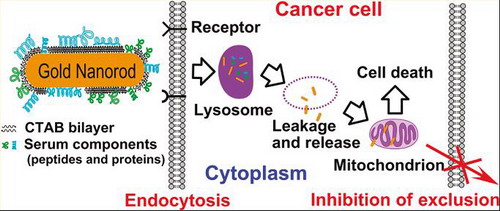Recently, Prof. Chunying Chen’s and Prof. Xiaochun Wu’s groups at National Center for Nanoscience and Technology have published an on-line article “Selective Targeting of Gold Nanorods at the Mitochondria of Cancer Cells: Implications for Cancer Therapy” in Nano Letters (Publication Date (web): December 27, 2010; http://pubs.acs.org/doi/suppl/10.1021/nl103992v).
They found that gold nanorods (Au NRs) can effectively kill tumor cells while hardly affect the physiological functions of normal cells and adult stem cells. The reason is that Au NRs have different trafficking process in three types of cells. In tumor cells, internalized Au NRs selectively target at mitochondria, destroy their structures, affect metabolic functions and finally cause cell death. While in normal and stem cells, Au NRs remain in lysosomes and do not decrease their viabilities. Although similar uptake pathways are involved in the internalization of Au NRs in three types of cells, the cell-specific effects come from sensitivity or resistance of lysosomal membrane to surface molecules of Au NRs. This finding provides a good opportunity to design smart nanocarriers or nanoparticles with organelle-target to overcome cancer.
Gold nanorods have many advantages like facile synthesis, controllable size and shape, good biocompatibility, and unique optical and electronic properties. Therefore, Au NRs are becoming promising materials applicable in biomedicine such as near-infrared imaging, X-ray computed tomography,biosensing,drug/gene delivery,and thermal therapy of tumor, due to their unique physiochemical and optical properties.Prof. Chen and Wu have published a series of cooperative researches about biological effects and application of Au NRs. They established integrated techniques to study the distribution and fates of Au NRs in vivo (Anal Bioanal Chem, 2010, 396: 1105-1114). By changing the aspect ratio and surface modification of Au NRs, they made the uptake and cytotoxicity of Au NRs controllable (Biomaterials 2010, 31: 7606-7619). They also found that gold nanorods coated with a shell composed of Pt nanodots exhibit peroxidase-like and catalase-like activity that can replace conventional enzyme-linked immunosorbent assay (ELISA) (Biomaterials 2011, 32: 1139-1147).
These researches were financially supported by Chinese Academy of Sciences, National Basic Research Program of China from Ministry of Science and Technology, and National Natural Science Foundation of China.

Figure. The fate and trafficking of Au NRs in cancer cells and the following cellular responses
Recently, Prof. Chunying Chen’s and Prof. Xiaochun Wu’s groups at National Center for Nanoscience and Technology have published an on-line article “Selective Targeting of Gold Nanorods at the Mitochondria of Cancer Cells: Implications for Cancer Therapy” in Nano Letters (Publication Date (web): December 27, 2010; http://pubs.acs.org/doi/suppl/10.1021/nl103992v).
They found that gold nanorods (Au NRs) can effectively kill tumor cells while hardly affect the physiological functions of normal cells and adult stem cells. The reason is that Au NRs have different trafficking process in three types of cells. In tumor cells, internalized Au NRs selectively target at mitochondria, destroy their structures, affect metabolic functions and finally cause cell death. While in normal and stem cells, Au NRs remain in lysosomes and do not decrease their viabilities. Although similar uptake pathways are involved in the internalization of Au NRs in three types of cells, the cell-specific effects come from sensitivity or resistance of lysosomal membrane to surface molecules of Au NRs. This finding provides a good opportunity to design smart nanocarriers or nanoparticles with organelle-target to overcome cancer.
Gold nanorods have many advantages like facile synthesis, controllable size and shape, good biocompatibility, and unique optical and electronic properties. Therefore, Au NRs are becoming promising materials applicable in biomedicine such as near-infrared imaging, X-ray computed tomography,biosensing,drug/gene delivery,and thermal therapy of tumor, due to their unique physiochemical and optical properties.Prof. Chen and Wu have published a series of cooperative researches about biological effects and application of Au NRs. They established integrated techniques to study the distribution and fates of Au NRs in vivo (Anal Bioanal Chem, 2010, 396: 1105-1114). By changing the aspect ratio and surface modification of Au NRs, they made the uptake and cytotoxicity of Au NRs controllable (Biomaterials 2010, 31: 7606-7619). They also found that gold nanorods coated with a shell composed of Pt nanodots exhibit peroxidase-like and catalase-like activity that can replace conventional enzyme-linked immunosorbent assay (ELISA) (Biomaterials 2011, 32: 1139-1147).
These researches were financially supported by Chinese Academy of Sciences, National Basic Research Program of China from Ministry of Science and Technology, and National Natural Science Foundation of China.

Figure. The fate and trafficking of Au NRs in cancer cells and the following cellular responses
 Close Page
Close Page- Text Size: A A A
 Printer Friendly
Printer Friendly
